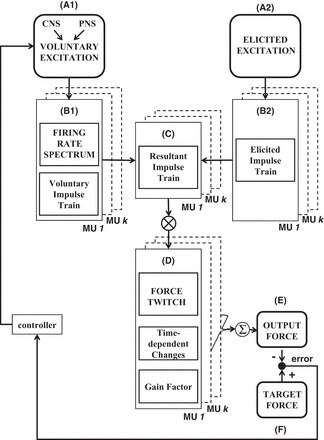Fig. 1.

Model schematic. The force model has 2 inputs: the voluntary input excitation (A1) and the elicited input excitation (A2). The former represents the sum of all excitatory and inhibitory inputs from the central nervous system (CNS) and from the peripheral nervous system (PNS) to all the motor units in the pool of a muscle. The latter represents the effect of electrical stimulation to a muscle or nerve supplying a muscle. The voluntary input excitation determines the firing behavior and impulse trains of motor units (MUs) during voluntary contractions (B1). The voluntary impulse trains interact with the elicited impulse trains (B2) if motor units are concurrently activated by the elicited input excitation. The resultant impulse trains (C) include the combined effect of both excitation sources. They are convolved with the time-dependent and firing rate-dependent motor unit force twitches (D) to compute the force contribution of the active motor units. Motor unit forces are summed to obtain the muscle output force (E), which is compared with the target force (F). The tracking error between output and target force is used to adjust the input excitation. See text for additional details.
